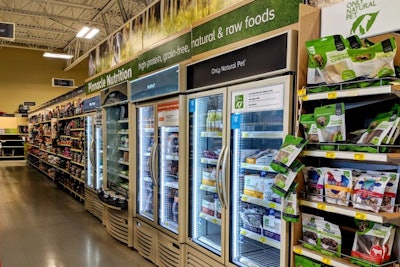
With the fresh/frozen pet food trend still going strong, one of the things pet specialty stores almost certainly have is a refrigerator and/or freezer to store the relevant products. Even grocery stores are getting in on the action. Fortunately, setting up and maintaining such a space is easy as long as the equipment is reliable.
Considerations for manufacturers and retailers
“The only thing the retailer and the manufacturer can do when it comes to fresh/frozen product is just to have the proper equipment to store it in,” says Frank LaPosta, business development manager for Minus Forty, a freezer and refrigerator merchandiser. “So if it’s fresh/refrigerated product you need a good working refrigerator, and if it’s frozen product you want a good freezer so it will maintain the proper temperatures of the food being stored in there.”
Fresh products don’t have the same shelf life as kibble, so it’s important for manufacturers and retailers to stay on top of expiration dates and rotating stock. Frozen products are easier, according to LaPosta, because as long as they are properly frozen they will last for quite some time.
Equipment maintenance is also key, and special attention should be paid to keeping the condenser clean.
“What happens is the refrigeration system pulls heat out of the unit, it doesn’t put cold in it,” says LaPosta. “So that heat needs to go somewhere. There’s a piece of equipment called the condenser, and its job is to take that heat being pulled out of the box and dissipate it out of the bottom vent of the unit. That condenser [particularly if it’s a grill style] can get very dirty and clogged very fast. And if you’re not cleaning it out your compressor has to work harder and harder and you might get compressor failure, or you might get units that won’t keep cold as easily because the compressor is working harder.”

Minus Forty uses a different condenser design that allows for dirt and hair to flow more freely through the system. As a result, the condenser is less likely to get clogged (which could lead to compressor failure) and doesn’t need to be cleaned as often as other designs. | Courtesy Minus Forty
Partnering for sales and success
Most of the time the retailer gets to decide what kind of equipment to buy, but sometimes a pet food manufacturer will step in with their own ideas.
“On the retailer end, the key is to have a good working merchandiser that keeps the product temperature consistent and also helps you sell the product (nice glass door, etc.),” says LaPosta. “Most independent retailers have their choice of equipment to buy, but some manufacturers are a little stricter; they want to maintain control of the units so they’ll order and place them themselves.”
Overall, as with most things, communication between the manufacturer and retailer (which then ties to the information the retailer will be able to pass along to the customer) is key to ensuring both product and presentation are optimal.

















